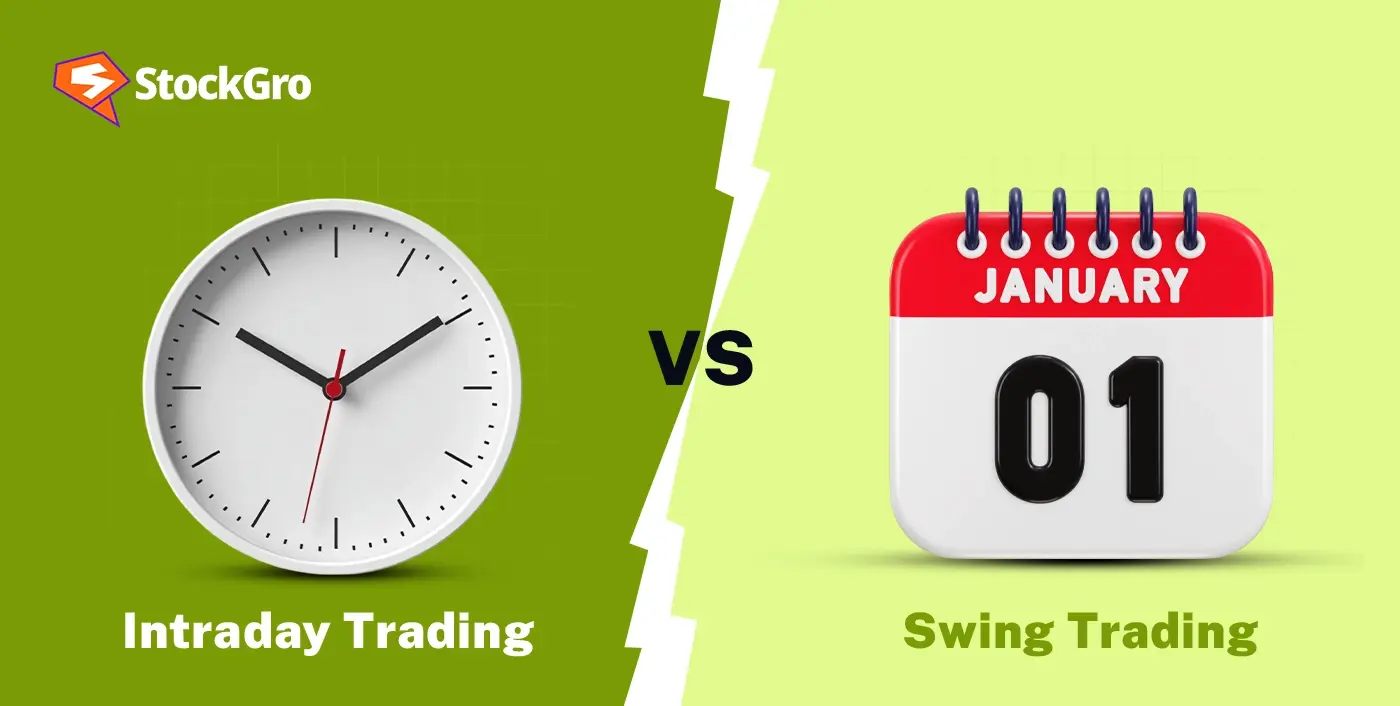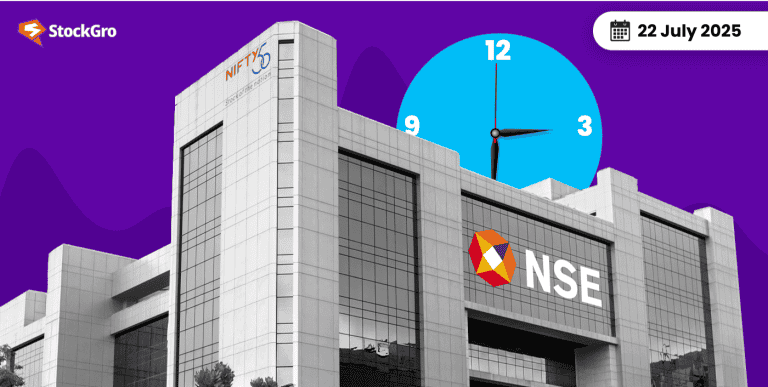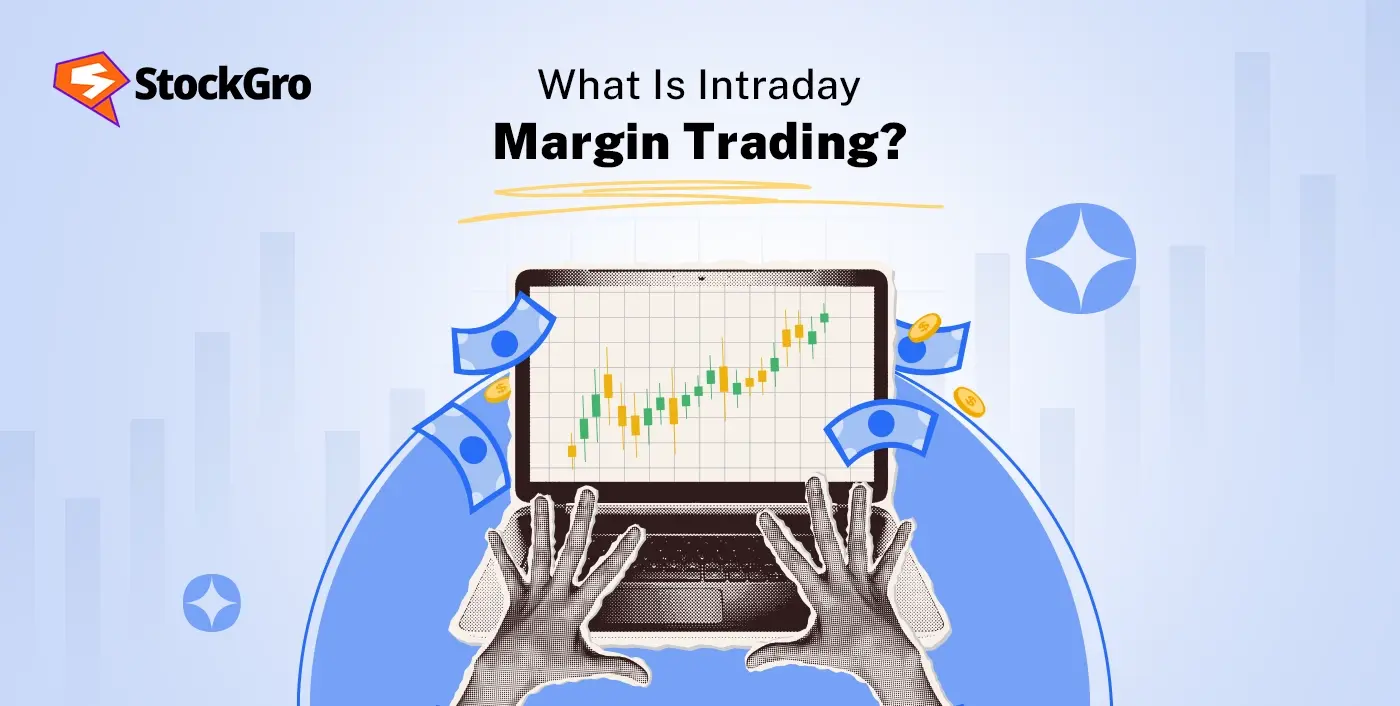
The stock market is not only about buying low and selling high, it’s about how and when to do it. That’s where different trading styles come in. There are two main styles of trading stocks in the market: Intraday and swing trading. Both can give profits from price movements, but their styles, timeframes, and risks are entirely different.
Let’s understand the difference between intraday vs swing trading, and which strategy can be right for you.
What is intraday trading?
Intraday trading, also known as day trading, is one of the most popular methods of trading in the stock market. It involves buying and selling stocks or any financial instruments on the same day during trading hours. The aim is to benefit from small price movements during the day. Trades are not held overnight or for more than a few hours. Even a small 2-3% rise in a few hours can make a profit for the traders.
What is swing trading?
In swing trading, stocks are held for a few days or sometimes even for a couple of weeks. The goal here is to capture a bigger price movement over a longer period. Swing trades are done with more precision and detailed analysis of technical charts and fundamental factors to find stocks that may have high volatility in the coming days. These traders are less concerned about minute-to-minute price action and more interested in broader market trends and volume.
Key differences between intraday vs swing trading
While both methods involve buying and selling stocks to earn profits, their approach and execution are different.
| Aspect | Intraday trading | Swing trading |
| Holding period | Entry and exit are done on the same trading day. No position can be carried overnight. | These are held for days to weeks. Waiting for a bigger price move over time, rather than quick actions. |
| Time commitment | Requires proper attention during market time. Traders often watch charts all day to track every move closely. | Doesn’t need constant monitoring of charts and patterns. Making it suitable for people with full-time jobs. |
| Risk level | Higher risk due to price volatility within a day. A single bad trade can cause major losses. | Moderate risk. While there’s overnight risk from news or events, there is time to plan and adjust the strategy. |
| Profit per trade | Profits are usually small per trade, but multiple trades can be done in a day to add to earnings | Aims for larger profits per trade because they hold stocks for longer durations and target bigger price moves. |
| Number of trades | Traders tend to make several trades a day. Frequency is high. | Just a few trades per week are enough. It’s more about quality than quantity. |
| Technical skills needed | Need strong technical analysis skills, fast decision-making, and the ability to manage risk quickly. | Use of both technical and fundamental analysis to do research. |
| Capital requirements | Traders use margin with less capital, but with proper leverage and risk management | Requires less margin, and can be started with any amount of capital or as per the risk appetite. |
| Impact of news/events | Not affected by overnight news, as they are closed during the market hours. | Highly exposed to overnight risks. News after market hours can affect the stock’s prices the next day. |
Pros and cons of intraday trading
Intraday trading might sound like an exciting way to make money. But it also has some major disadvantages. Let’s look at both sides:
Pros:
- Quick returns: If the analysis is right, profits can be quickly secured within hours or minutes.
- High profit potential: Multiple opportunities daily help in substantial gains.
- No risk of news: Since trades are closed before the market ends, there’s less risk of unexpected news.
- Leverage benefits: Can use intraday margin leverage to get higher returns with less capital.
Cons:
- Extreme time commitment: Requires hours of intense focus daily. Juggling through charts and indicators.
- Possibility of heavy losses: Strategies for quick profits can also lead to losses if risk management is not followed.
- Commission costs: Frequent trading means higher transaction costs and commissions paid in brokerage.
- Requires technical skill: Requires knowledge of technical indicators, price action, and risk management inside out.
Pros and cons of swing trading
Swing trading is much slower than intraday, making it a potential option for part-time traders. But like everything in the stock market, it has its own set of pros and cons:
Pros:
- Flexible schedule: No need to monitor charts constantly. Market analysis can be done in the after-hours as well.
- Lower transaction Costs: Trades are fewer, which means lower commission expenses.
- Less stressful: No need for split-second decisions.
- Trend capture: Ability to capture major market moves for larger gains.
Cons:
- Overnight risk: Trades are exposed to gaps and after-hours news events
- Patience required: Traders may have to wait weeks for the right setup
- Tied-up capital: Money is locked in positions for extended periods
- Weekend gaps: Weekend gaps can significantly affect the market.
Which is more profitable: Intraday trading vs Swing trading?
The answer to this depends on the trader, not just the method. Intraday trading can give quick profits, but it’s quite easy to lose money if the strategy is not right or the actions are not prompt. SEBI study finds that 7 out of 10 individual intraday traders incurred losses in FY 2022-23.
Swing trading is slower but gives time to make informed decisions. It is considered better for consistent profits over time, especially for those with less experience and time.
Being profitable is not about strategy, but how well you understand the market and stick to it. Consistency and discipline matter more than speed.
Which strategy is right for you?
Choosing between intraday vs swing trading depends on time, risk tolerance, and knowledge of the market. If you prefer quick trades and can actively monitor the market during the day, intraday trading may suit you. If you have limited time and prefer holding positions for a few days, swing trading could be a better fit.
For beginners, starting with swing trading is generally easier. As you gain experience, you can explore intraday trading gradually with proper risk management.
Conclusion
When it comes to intraday vs swing trading, there’s no clear winner. Both have their pros and cons. It all depends on your trading style, time availability, and risk appetite. Swing trading can be more suitable for beginners, whereas experienced traders may prefer the faster pace of intraday trading.
FAQs
Yes, most trading platforms allow both intraday and swing trading. While placing an order, you can choose the type: intraday for same-day trades or delivery-based for holding stocks overnight. The platform interface typically provides clear options to manage both styles of trading easily.
Yes, swing trading may be more tax-friendly. Profits from swing trades held for more than one day are considered capital gains, which are taxed at lower rates. Intraday trading is treated as a speculative business income and taxed as per your income slab, usually resulting in a higher tax burden.
Intraday trading allows higher leverage depending on the broker and stock, which means you can trade with less capital. For swing trading, since positions are carried overnight, full margin is usually required.
Generally, swing trading is considered safer for beginners because it allows more time for decision-making and avoids the intense volatility of intraday moves. However, it still carries risks like overnight news and market gaps. Risk depends on your strategy, discipline, and how well you manage your trades.
Yes, swing trading is ideal for part-time traders. Since you don’t need to monitor the market throughout the day, you can analyze charts after market hours, place trades, and check in once or twice a day. It’s suitable for working professionals or students with limited screen time.
The capital required for intraday trading or swing trading depends on your risk tolerance, duration of trade, and the margin rules of the brokerage platform. Begin trading with an amount that you can afford to lose. Both intraday and swing trading can be started with any amount of money, but in intraday trading, the traders must look out for the margin.

